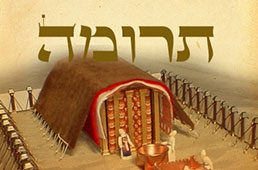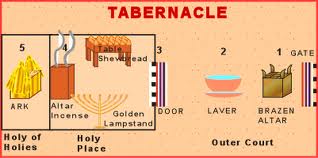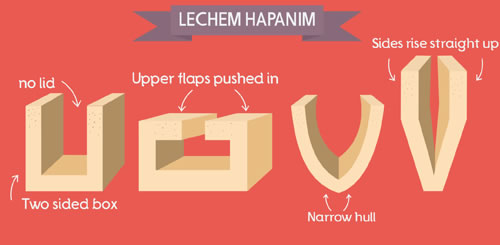
Bread of All Bread


Shalom,
This Shabbat we will read the Torah Portion “T’rumah” in the book of Exodus.

In this Torah portion Moses is commanded to build a sanctuary:
וְעָשׂוּ לִי, מִקְדָּשׁ; וְשָׁכַנְתִּי, בְּתוֹכָם
And let them make Me a sanctuary, that I may dwell among them…
G-d then gives description of various articles to be placed in the tabernacle:
- The Menorah – to bring light in the sanctuary
- The outer altar – for sacrifices
- The inner altar – for the incense
- The ark – ארון (ARON) to hold the tablets,
- The cover for the ark כפורת (KAPORET)
- The two cherubim of gold – כרובים (K’RUVIM). G-d voice was heard between those cherubim
- The table – שולחן (SHULKHAN) – to hold the showbread

Probably out of all the articles, purpose of which more or less could be rationalized, the one that is very hard to understand its purpose is the table holding the showbread.
Maimonides in his book “Guide for the perplexed”, giving explanation for the tabernacle and its internal articles, actually admits that he has no clue to its purpose…
Let’s anyway try and understand what it is all about.
In Hebrew, the showbread is called לחם הפנים LECHEM HAPANIM, which translates literally as “face bread.”
The Talmud says that it was called lechem hapanim because it had many “faces,” i.e., many sides.
As we saw, the showbread was to be placed on the table:
“On the table, the showbread should be placed before Me at all times.
As the tabernacle and all its articles were portable, the Showbread remained on the table at all times, even when the table was in motion carried by the children of Israel in the desert.
The Torah gives us more details about this commandment—how many loaves of bread there should be, their weight, and the day of the week on which they should be brought as an offering to the Creator:
We learn that the showbread was placed on the table in two stacks, each stack containing six loaves. (12 loaves altogether). Frankincense (resin extracted from the Boswellia sacra tree) was placed on the table with the showbread.
Fresh loaves of bread replaced the old loaves on the table every Shabbat, and the Kohanim (priests) would eat the loaves that were removed from the table.

· The loaves were uniquely shaped, and they had to remain whole and unbroken during the baking and afterwards.
· The loaves were standing exposed to the air for a full week, and they must have been made according to a special recipe, because they never became moldy or dried out.
· The loaves had to be baked quickly so they wouldn’t become chametz (leavened).
· The loaves were fairly large, each weighing almost five kilograms (11 lbs.).
The Talmud brings several opinions about the shape of the showbread.
The shape:
LECHEM HAPANIM was like a matza and had a distinctive shape either like a “dancing boat” in the shape of the letter “v” or like an “open box” like the Hebrew letter chet.

The quantity:
Abarbanel suggests that the twelve breads might represent the twelve months of the year, showing how G-d provides for all the whole year long.
Alternatively, they stand for the twelve tribes of Israel who will be the recipients of G-d’s blessings.
The Talmud tells us that there was a family named Garmu who were experts at preparing the showbread. The sages asked them to teach other people the secrets of preparing the showbread, but they refused and were fired.
Specialists were brought from Egypt, who knew how to bake, but they did not know how to take the loaves from the oven as well as the Garmus did, and in spite of their many attempts, their loaves became moldy.
The Garmus were summoned back to their job, and the showbread was once again offered. When they were asked why they wouldn’t teach anyone else how to do the work, they said, “We know that the Temple will be destroyed, and we are concerned that an unworthy man will learn how to bake the showbread and use it to serve an idol.”
Although, Maimonides could not provide an explanation for the Showbread, Kabballah does give us some clues.
It tells us that each article in the sanctuary represent parallel spiritual forces.
The showbread is a symbol for nourishment which is constantly supplied by the Creator in abundance. And, in order for the blessing to be present and materialize at all times, the Showbread had to be present constantly.
It therefore is the spiritual source of all the food mankind receives. Thus this “inner bread” is in fact the “Bread of All Bread”.
And the function of the table – שולחן (SHULKHAN) is derived from its root שלח (to send out), meaning that it sends out bread from its spiritual level of existence to the material world in its material form and shape.
According to the Jewish tradition, blessing can only occur when there is some material substance which could carry on the blessing, as in case of Prophet Elisha’s oil and Prophet Elijah’s flour.
There is a custom that any leftovers of bread should be present and covered during the meal grace so that the blessing could be carried out by those.
Speaking of the table (שולחן), in psalm 23 there is the verse:
תַּעֲרֹךְ לְפָנַי שֻׁלְחָן נֶגֶד צֹרְרָי
You prepare a table before me in the presence of my enemies.

מִזְמוֹר לְדָוִד, ה’ רֹעִי לֹא אֶחְסָר
בִּנְאוֹת דֶּשֶׁא יַרְבִּיצֵנִי, עַל מֵי מְנוּחוֹת יְנַהֲלֵנִי
נַפְשִׁי יְשׁוֹבֵב, יַנְחֵנִי בַּמַּעְגְלֵי צֶדֶק לְמַעַן שְׁמוֹ
גַּם כִּי אֵלֵךְ בְּגֵיא צַלְמָוֶת לֹא אִירָא רָע כִּי אַתָּה עִמָּדִי
שִׁבְטְךָ וּמִשְׁעַנְתֶּךָ הֵמָּה יְנַחֲמֻנִי
תַּעֲרֹךְ לְפָנַי שֻׁלְחָן נֶגֶד צֹרְרָי
דִּשַּׁנְתָּ בַּשֶּׁמֶן רֹאשִׁי כּוֹסִי רְוָיָה
אַךְ טוֹב וָחֶסֶד יִרְדְּפוּנִי כָּל יְמֵי חַיָּי וְשַׁבְתִּי בְּבֵית ה’ לְאֹרֶךְ יָמִים
A psalm of David.
Now listen to a nice version of this Psalm
by Etty Ankery:
https://www.youtube.com/watch?v=8rnj2cwlRl4
Shabbat Shalom,
Yoel & Orly
Many ask us for a permission to redistribute our newsletters. By all means, please do feel free to forward this newsletter to anyone you wish!
Access the archive of our previous posts at:
https://www.ulpanor.com/category/blog/
Subscribe to our newsletters on our website at the bottom of the home page:





